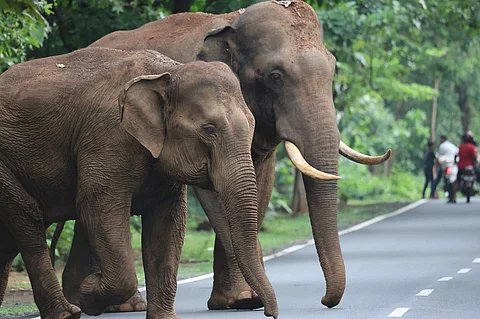

Palmyra palm trees in Odisha are providing dual benefits by reducing lightning-related deaths and serving as a food source for elephants during lean seasons.
The state has initiated a plantation drive to increase their numbers, addressing both human-elephant conflict and environmental safety.
The trees' felling is now restricted to preserve these advantages.
Palmyra palm trees are proving beneficial to Odisha in a two-fold way. The tall trees are helpful in the reduction of deaths due to lightning during monsoon, and at the same time, provide food to elephants during the lean season.
Apart from paddy, sugarcane and bananas, elephants love to gorge on palm tree fruits, known as tala in Odia and tal in Bangla. The blackish coloured round fruits ripen in July-August, a period when elephants do not get much food, either in the forest or in the paddy fields.
Odisha has started a major palm tree plantation drive across its 30 districts. Once planted, the young seedlings take a number of years to grow. Even a few years back, palm was not a protected species in the state. Its illegal felling and sale were permitted and carried out by merchants from outside, especially from Tamil Nadu. However, this is now banned.
According to NVK Ashraf, who works at the Wildlife Trust of India, the number of Palmyra palm trees is on the decline. “It is found in a few states like Andhra Pradesh, West Bengal, Odisha and Tamil Nadu on unused lands and along agricultural bunds. It is the state tree of Tamil Nadu.”
In Angul district of Odisha, palm trees are mainly grown on private lands, especially on bunds in farmlands. The straight trees absorb lightning strikes and protect farmers as well as agricultural workers. Elephants also consume palm fruits. Though it is not their primary food source, the animals like its sweet taste.
In a letter dated 2022 and addressed to the forest department headquarters in Bhubaneswar, Biswajit Mohanty, secretary of non-profit Wildlife Society of Orissa, had urged that palm trees could reduce human-elephant conflict by providing food for the animals as well as arrest deaths due to lightning strikes. He feared that the indiscriminate felling of palm trees by timber merchants would lead to a rapid depletion of food meant for elephants.
In the letter, Mohanty claimed to have provided photographs as well as GPS coordinates earlier of felled trees and sawn logs of palm trees noticed in Angul and Dhenkanal. In Odisha, Dhenkanal has a high incidence of human-elephant conflict. In both the districts, drones are being used to tackle human-elephant conflict.
Remarking on the letter, Angul divisional forest officer Nitish Kumar said palm trees are still in plenty in the district. “Earlier, a few cases of palm trees being felled by timber merchants had come forward. In the past, traders could cut them without having permits. But this is not the case now anymore, as an order was passed prohibiting its felling in 2023.” He added that in the past, there has been a considerable demand for palm timber, which is durable, from Kolkata. This led to rampant felling. But now as permit is required to fell palm trees, arrests can be made for illegal felling of the trees.
Dhenkanal divisional forest officer Sumeet Kumar Kar explained that as the timber derived from palm is quite durable, there is demand for it outside Odisha. “However, at present it is a restrictive species as far as felling is concerned. On getting tip-offs, vehicles transporting the tree trunks are seized by the forest department.”
Several districts of Odisha witness a high incidence of human-elephant conflict. To warn communities, early monitoring systems are in place. Village heads are called to distribute information about elephant movements. Awareness camps are also organised from time to time.
In Dhenkanal, the number of human deaths stood at 58 in the past two years. In the same period, the forest department received applications for injuries in 92 cases. Compensation paid to beneficiaries amounted to approximately Rs 10.5 crore. “Four years back, the number of deaths in a year used to 35 per year on an average, but last year it was 26. So, there has been 25 per cent reduction in deaths,” Kar said. In Angul, from 2024 till the time of filing this story, human deaths stood at 20 and injuries at 18.
Apart from paddy and other sources of fodder, farm ponds dug under the Mahatma Gandhi National Rural Employment Guarantee Act are also likely to attract elephants because of the ready availability of water. Due to irrigation facilities, apart from paddy, other crops are also cultivated which attract elephants. However, palm is a good food source for the animals during the lean season.
When asked if palm trees can reduce conflict incidents, Kar pointed out that it will possibly take a decade to do a study on this. “It is true that elephants prefer palm fruits. The existing trees were planted by farmers several years back. However, the Odisha government has been planting palm to arrest lightning deaths. The trees are planted near the periphery of forest blocks. This helps set a natural demarcation for forest boundaries.”
Because of their height, palm trees are a good lightning conductor. Last year, the guideline was to plant palm seedlings on reserved forest boundaries to demarcate the former areas from revenue ones. This year, it is more encompassing, with plantation taking place even in revenue lands. Last year (2024-2025), the forest department planted 80,000 palm seedlings in Dhenkanal. This year too (2025-26), the number is the same. In Angul, in 2024-2025, 74,000 palm seedlings were planted. In 2025-2026, the number stands at 70,000.